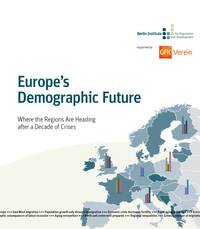- kennisvanstadenregio
- Kennisdossiers
- Kennisdossier Bevolkingsdaling
- Publicaties over krimp (2022-2006)
- Europe's Demographic Future
Inhoud
- Bevolkingsdaling: wat is het?
- Beleid voor bevolkingsdaling: een korte geschiedenis
2.1 De krimp bestrijden
2.2 Bewustwording: Eerste Actieplan Bevolkingsdaling – 2009
2.3 Programmering en uitvoering: Tweede Actieplan Bevolkingsdaling – 2016
2.4 Provincies
2.5 Gemeenten - Bevolkingsontwikkeling en prognoses
3.1 Inleiding
3.2 Drijvende krachten achter bevolkingsontwikkeling
3.3 Bevolkingsontwikkeling in Nederland
3.4 De zeggingskracht van prognoses
3.5 Onwaarschijnlijkheden en scenario’s
3.6 Conclusie - Ontwikkelingen per domein
4.1 Wonen
4.2 Gezondheid en zorg
4.3 Onderwijs
4.4 Regionale economie en arbeidsmarkt
4.5 Bereikbaarheid - Praktijkvoorbeelden
5.1 Aanpak huisartsentekort
5.2 Toekomstgericht bouwen in Biggekerke
5.3 Zelfrijdende shuttlebus bij Ommelander ziekenhuis
5.4 Toekomst wonen in Beltrum
5.5 Gefaseerde strategie voor de herontwikkeling van Rolduckerveld
Contact
Europe's Demographic Future
Where the Regions Are Heading after a Decade of Crises
Europe looks back on a turbulent decade in which the financial, economic and debt crises led to mass unemployment and brought entire states to the brink of insolvency. As hundreds of thousands of refugees made their way to Europe, many people showed a great willingness to help them, but at the same time this mass migration movement led to new conflicts. All of this has also had a major impact on population development. New migration patterns have emerged while old ones have changed, and in many places fewer people have wanted to start families in the face of economic insecurity. So where do Europe’s regions stand today and what are their long-term prospects? The Berlin Institute for Population and Development has examined these questions using a large number of demographic and socio-economic indicators.
Lees de publicatie Europe’s Demographic Future


